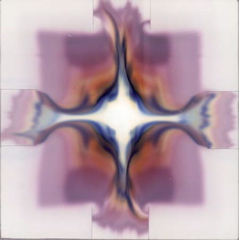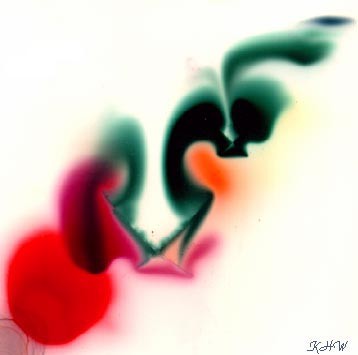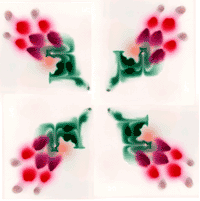
What is CHROM-ART?
In this artful and graphical procedure shapes develop from colors, and more colors from the shapes. This sounds mystical, but can be understood literally.
There are sharply separated outlines made without the use of the stroke of a brush or pen. There are fine transitions of colors without using brushes. Delicate tinges develop from laying on dark colors and are in tension to intensively colored shapes, that can develop thereof. In contrast to painting where mixing of the colors results in the final expression, CHROM-ART separates the colors to reach the final result.
The secret of CHROM-ART
lies in the particular properties of the surface used. Thin layer chromatography plates, used in analytical and preparative separation of chemical substances, give those impressions of color and shape if used in CHROM-ART. The surface consists of silicone dioxide, which is rich in pores. The inner surface is the size of three tennis courts. The dyes and solvents react differently with this richly structured surface. The longer these miniature distances in the surface of the plates are, the more variety exists in arranging the colors by separating in components, and changing the forms by altering the surface. If all the pores of one plate were arranged in one row they would reach more than half way to the sun! Without this special structure CHROM-ART would not be possible. This explains why CHROM-ART is different from all known painting techniques.
Knowledge of chromatography and lots of fantasy are needed to work with CHROM-ART. The limits that exist in the scientific usage of chromatography are knowingly ignored, and new possibilities arise and are utilized in the formation of effects. Once a picture is planned it can either be completed in one or a few steps, or can be changed in many small developing steps until the expected impression is reached. But always the right moment needs to be observed to reach the desired effect. All "flowing pictures" are unique, sometimes they are similar, but never identical .
In CHROM-ART there are no limits in the variety of laying on colors in different shapes, of developing in colors and shapes and their reciprocal action. There are geometrical forms arranged by the rules of symmetry as well as stirring formations leaving free play to the fantasy of the viewer. Pictures originating from CHROM-ART are full of expressions: unexpected dimensions, contrast from intense colors to fine tinges, contours without the stroke of a brush, different impression depending on how the light falls.
CHROM-ART was invented in 1980 by the chemists Dr. Herbert Halpaap and Dr. Heinz Hauck as "side product" of their professional activity. They researched and described the factors influencing the process.
H. Halpaap (1916-1987) took up this work after his retirement from industry. During half a year under simple conditions -the balcony of his house served as laboratory, food jars as chromatography jars- he created several impressive "flowing pictures". Further development of the technique resulted. The first representations were ruled by geometry and symmetry. Then those limits were left behind and he created asymmetric enthusiastic scenes. H. Halpaap did not see himself as an artist. He simply enjoyed creating beautiful compositions of color and form.

panta rhei
everything flows
The theme of this new graphic technique called CHROM-ART is a phrase that Heraclitus, Greek philosopher of Ephesus, formed about 500 BC. Flowing of the colors is an important factor in this technique.
All pictures shown here are examples of "flowing pictures". So "panta rhei" should be the motto for this page.
The following pages show Chromart pictures, sorted by the way they were developped.
Pictures by Karla Halpaap-Wood:
